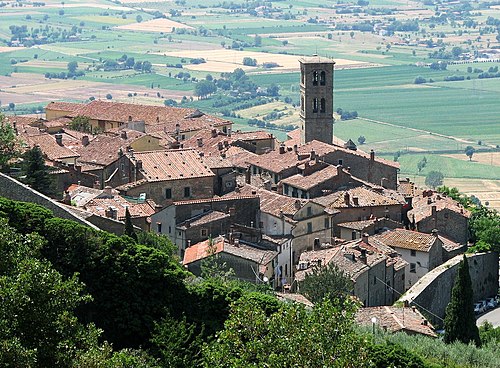History
Ancient Cortona was one of the twelve cities of Etruria. In the 6th century it was destroyed by the Lombards but was soon rebuilt. From that time until 1325 the city and its territory were assigned ecclesiastically to the Diocese of Arezzo.
At the beginning of the 14th century, however, Arezzo and Cortona were still involved in the struggles between the Guelfs and the Ghibellines. Arezzo was Ghibelline in allegiance, supporting the emperor; Cortona, which had been conquered by Arezzo in 1258, was Guelf, and supported the papal states. [3] In Arezzo, two aristocratic factions contended for domination, the Verdi and the Secchi, and when the latter gained control they had their leader, Guido Tarlati of the castle of Petramala, elected bishop of Arezzo. He embarked on an activist program, building a wall around the city, and creating a new silver and copper currency. [4] His program also included military conquest: Lusignano, Chiusi, Fronzoli, Castel Focognano, Rondina, Bucine, Caprese, Lacerina, and Monte Sansovino. This expansionist activity greatly alarmed both the Florentines and Pope John XXII, who, though safely settled in Avignon, feared for the loss of church territories and the threat to the papal states. He determined to take action against Bishop Guido, who was paying no attention to his angry protests. [5]
In the year 1325, at the request of Guglielmo Casali, [6] Captain (Gonfaloniere) of the People of Cortona, Pope John XXII raised Cortona to episcopal rank, as a reward for the fidelity of its Guelph populace. [7] A month later, on 20 July 1325, the Bishop of Arezzo, Guido Tarlati de Petramala, was excommunicated. [8]
In the papal bull, "Vigilis speculatoris", dated 19 June 1325, Pope John XXII established the new diocese of Cortona by detaching its territory from the diocese of Arezzo. He created the church of S. Vincenzo, which had belonged to the monastery of Ss. Lucilla and Flora, the new cathedral. [9] In a bull of 29 June 1325, the Pope designated Rinaldo di Guido, parish priest of S. Andrea, the new Provost of the cathedral. In another bull, dated 30 June 1325, Pope John established the cathedral Chapter, composed of two dignities (Provost and Archdeacon) and eight Canons. [10]
The current Cathedral of Cortona became the diocesan seat only in 1507.
The diocesan seminary was founded by Bishop Francesco Perignani (1572–1577) in 1573. [11]
Diocesan synods
A diocesan synod was an irregularly held, but important, meeting of the bishop of a diocese and his clergy. Its purpose was (1) to proclaim generally the various decrees already issued by the bishop; (2) to discuss and ratify measures on which the bishop chose to consult with his clergy; (3) to publish statutes and decrees of the diocesan synod, of the provincial synod, and of the Holy See. [12]
Bishop Giovanni Alberti (1585–1596) presided over a diocesan synod in 1588. [13]
Bishop Cosmo Minerbetto conducted a diocesan synod in Cortona in 1624. [14] A diocesan synod was held in Cortona in August 1634 by Bishop Lorenzo della Robbia. [15]
Suppression of the diocese
On 18 February 1984, the Vatican and the Italian State signed a new and revised concordat. Based on the revisions, a set of Normae was issued on 15 November 1984, which was accompanied in the next year, on 3 June 1985, by enabling legislation. According to the agreement, the practice of having one bishop govern two separate dioceses at the same time, aeque personaliter, was abolished. Instead, the Vatican continued consultations which had begun under Pope John XXIII for the merging of small dioceses, especially those with personnel and financial problems, into one combined diocese. In Tuscany, this particularly affected three dioceses: Arezzo, Cortona, and Borgo San Sepolcro (Biturgensis).
On 30 September 1986, Pope John Paul II ordered that the dioceses of Arezzo, Cortona, and San Sepolcro be merged into one diocese with one bishop, with the Latin title Dioecesis Arretina-Cortonensis-Biturgensis. The seat of the diocese was to be in Arezzo, and the cathedral of Arezzo was to serve as the cathedral of the merged diocese. The cathedrals in Cortona and San Sepolcro were to become co-cathedrals, and their cathedral Chapters were to be a Capitulum Concathedralis. There was to be only one diocesan Tribunal, in Arezzo, and likewise one seminary, one College of Consultors, and one Priests' Council. The territory of the new diocese was to include the territory of the former dioceses of Cortona and Borgo San Sepolcro. [16]
